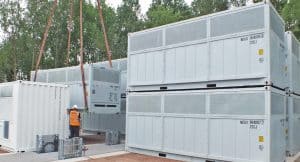
Britain, like most of Europe, is facing an energy crisis of epic proportions. Wholesale gas prices have surged again, putting the rocket under the UK’s price cap on household bills. Businesses are at risk of going bust as costs soar.![]()
The UK’s dependence on gas, which constituted 40% of its power last year, makes it particularly vulnerable and exposes the need for alternative sources of energy to the fossil fuel. As more energy comes from wind and solar, the country will also need power sources that can be turned on when demand spikes and the wind isn’t blowing.
One option is batteries. Here, we take a look at the energy storage technologies, new and old, that are already taking hold.
Lithium ion
The UK already has Europe’s largest amount of grid-connected batteries, according to researcher BloombergNEF. Its lithium ion battery fleet currently has about 1.9 gigawatts of capacity and will more than quadruple by the end of the decade.
These are essentially giant versions of the batteries in a mobile phone. They can charge during times when demand is low and electricity is cheaper, and then discharge when demand rises.
But lithium ion batteries have disadvantages. They can only provide power for relatively short periods of time. If there’s a period of more than a few hours this winter when the wind doesn’t blow, lithium-ion batteries won’t do much good. They’re more helpful to meet short bursts of demand or lulls in wind speeds.
Batteries are also in short supply and developers have to compete with massive demand from the automotive sector.
Reservoirs up mountains
“In periods where, over several hours, there’s a shortfall of energy, long-duration storage systems can come in and fill the gap,” said Nelson Nsitem, analyst at researcher BloombergNEF.
Right now, the UK doesn’t need so much longer-duration storage, but as wind makes up a growing amount of the power mix beyond 2035, it will become increasingly crucial.
One old-school alternative that’s already established in Britain is hydro power. Giant reservoirs hold vast amounts of water that can be released in seconds to spin turbines and generate electricity, such as at the Dinorwig Power Station in the mountains of north Wales and Cruachan Power Station inside Ben Cruachan mountain in Scotland. But these plants only work in certain locations, limiting their potential.
Liquid air
One British startup is compressing air into liquid form, using electricity. It can then generate power when the liquid is heated, expanding back into a gas and driving a turbine.
“Think of it as pumped hydro in a box,” said Rupert Pearce, Highview Power Ltd.’s chief executive officer. “There’s no energy transition without long-term storage and green stability services.”
Highview has a demonstration site near Manchester that’s already operational and is looking to scale up. The company has hired boutique investment bank Ardea Partners to lead a fundraising round targeting £380 million ($448 million) to build a 50-megawatt site. If all goes to plan, the company will start construction later this year and then move on to its next project, an even larger development in Yorkshire that would cost £750 million.
Other large-scale projects are planned in Australia and Spain.
The downside of Highview’s storage option is that it’s more expensive than lithium ion batteries. However, Pearce says the technology is already cheaper than fossil fuels. And the asset can operate for decades, a much longer lifetime than lithium ion batteries that would potentially have to be replaced after a few years.
Car parks
Connecting to the grid is expensive, so it makes sense to build energy hubs with more than one use. Hence, a huge and long-lasting battery has been installed in Oxford close to an electric car charging station.
London-listed company Invinity Energy Systems Plc has paired one of its vanadium flow batteries with a lithium-ion battery at the site. The flow battery, which can last for decades, will be used more heavily by Electricite de France SA’s Pivot Power unit, which offers the charging service to passing vehicles. This system preserves the lifetime of the lithium battery that is more prone to wearing down.
The batteries are there to support the grid — feeding energy back into the system at times of low supply and high demand.
Invinity also wants to scale up. The company is one of five finalists for public funding to support the next generation of long-duration energy storage. As part of a review into the electricity system, the government is considering how else to encourage the energy storage sector and ultimately shift the UK away from gas and toward a greater reliance on green technologies.
